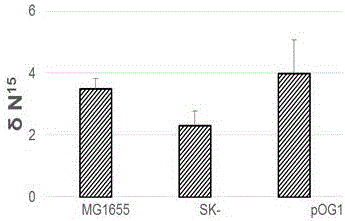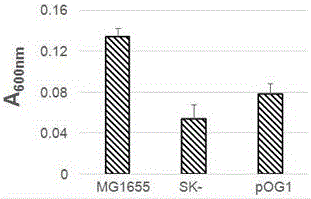Application of OG1 gene in biological CO2 capturing
A CO2 and gene technology, applied in the application field of OG1 gene in biological capture of CO2, can solve the problems of low carbon sequestration efficiency and high environmental conditions, and achieve the effect of high carbon sequestration efficiency
- Summary
- Abstract
- Description
- Claims
- Application Information
AI Technical Summary
Problems solved by technology
Method used
Image
Examples
Embodiment 1
[0028] Example 1 Carbon fixation isotope experiment According to carbon 13 Urea breath test design
[0029] The OG1 gene sequence is stored in Genbank, and its Genbank sequence number is NC_012920, with bases 9251 to 9655.
[0030] The preparation process of Escherichia coli pOG1 is as follows:
[0031] Human mitochondrial DNA was amplified by conventional PCR with primers F0 and PB2 (containing restriction sites).
[0032] F0:
[0033] GACGGTATCGATAAGCTTGATATCGAATTCATGACCCCTAACAGGGGC
[0034] PB2: ACTAGTGGATCCCCCGGGCTGCAGCTATGGTGAGCTCAGGTGATTGATACTCCTGATGC
[0035] The OG1 fragment recovered from the gel and the SK-plasmid were both digested with BamH I and EcoRI, and the purified digested product was digested with T 4 DNA ligase ligation, and the ligation product was directly transformed into Escherichia coli MG1655 strain. Spread on LB / AMP / ITPG / X-Gal plates and culture overnight at 37°C. Pick the white clone. The pOG1 subclone was sent to BGI for sequencing, and th...
Embodiment 2
[0050] Example 2 Utilize nitrogen source, carbon fixation coating experiment
[0051] C8 carbon-fixing solid medium: 40 mg of YNB (no amino acid and no ammonium sulfate), 5 mg of imported or analytically pure ammonium sulfate, 4 g of agar, dissolved in 80 ml of double distilled water, adjust the pH value to 8.0 with NaOH, and dilute to 100 ml.
[0052] The experimental process of using nitrogen source and carbon fixation coating is as follows:
[0053] Pick Escherichia coli MG1655, pOG1, SK- single colonies and culture them overnight for about 12 hours, take 20-30 microliters of the culture solution, centrifuge, wash with sterile water, and smear the plate. MG1655 without ampicillin, SK and pOG1 clone growth plates were supplemented with ampicillin at a concentration of 100mg / L. The plate was cultured in a 30°C incubator, and the parafilm was poked with a pipette tip to allow CO 2 Enter, record the growth time and take pictures after the colony grows out.
[0054] The resul...
Embodiment 3
[0055] Example 3 The experiment of consuming protons
[0056] Inoculate 0.1OD (absorbance value at 600nm, about 1×10 8 cells / mL) Escherichia coli clones in 6 tubes, 5 ml medium (medium formula: 300ml system, with 0.2g peptone, 0.1g yeast powder), cultured at 37 degrees 220rpm for 6 hours, measured OD 600nm The absorbance value was measured, and the pH of the medium was detected with a pH meter. The results are shown in Table 3.
[0057]
[0058] Escherichia coli culture generally becomes acidified gradually. In Table 2, the density of pOG1 bacteria is higher, but the pH is also higher (the culture medium is relatively more alkaline). It shows that the pOG1 cell consumes protons. The difference in pH between the two groups was statistically significant, P=0.05 (one-tailed).
PUM
 Login to view more
Login to view more Abstract
Description
Claims
Application Information
 Login to view more
Login to view more - R&D Engineer
- R&D Manager
- IP Professional
- Industry Leading Data Capabilities
- Powerful AI technology
- Patent DNA Extraction
Browse by: Latest US Patents, China's latest patents, Technical Efficacy Thesaurus, Application Domain, Technology Topic.
© 2024 PatSnap. All rights reserved.Legal|Privacy policy|Modern Slavery Act Transparency Statement|Sitemap



